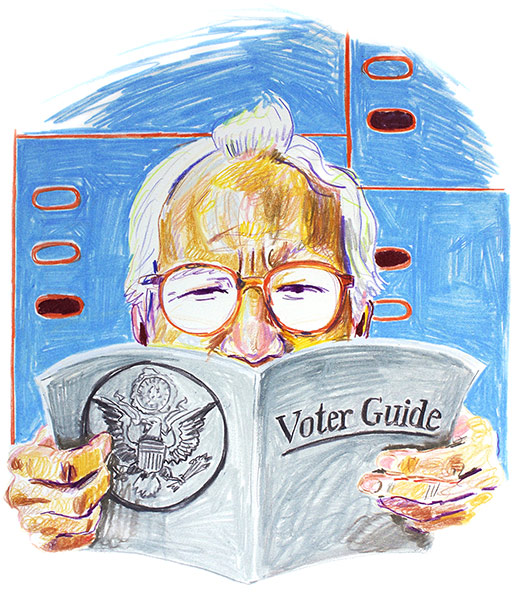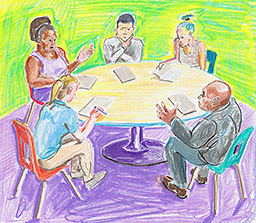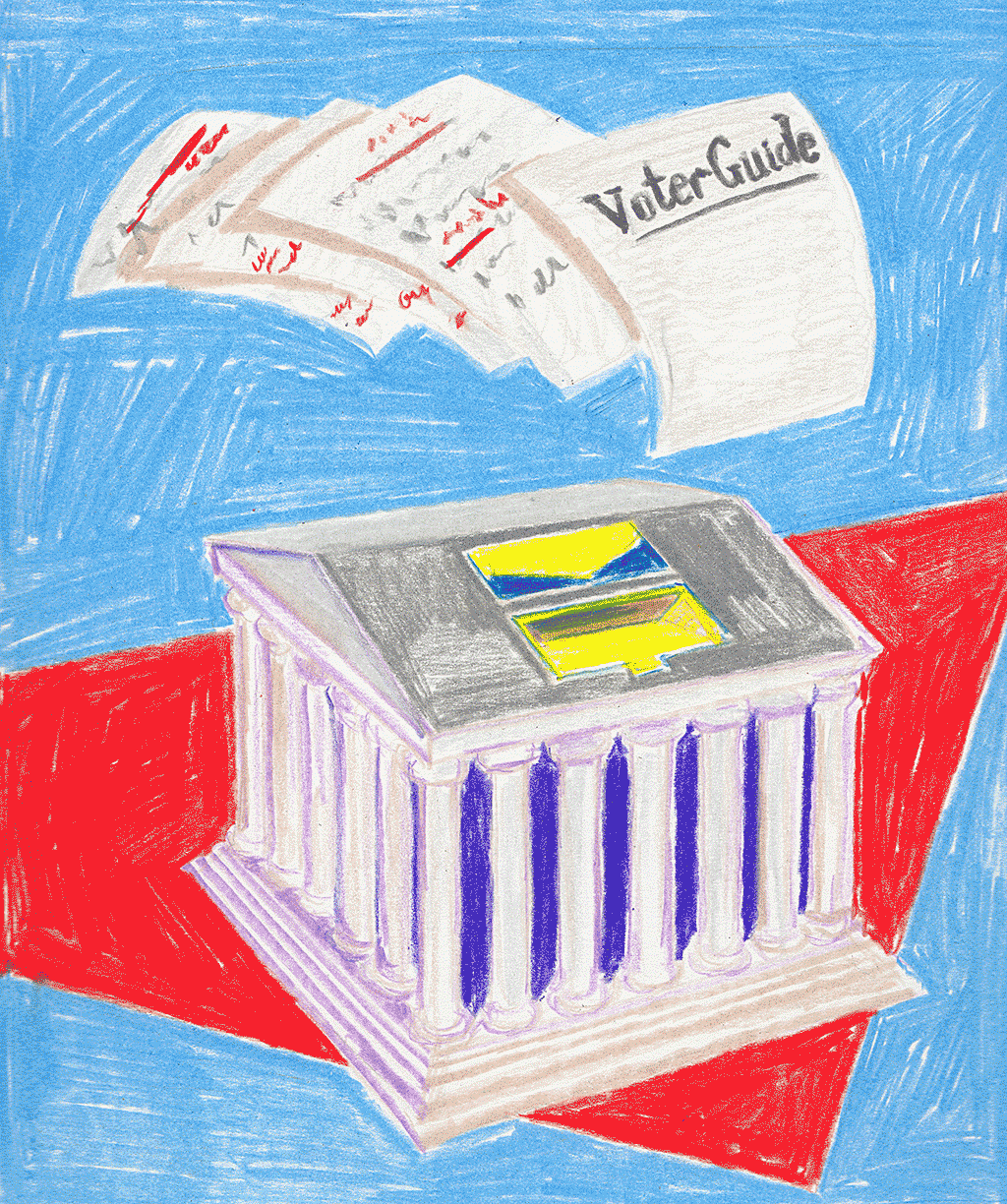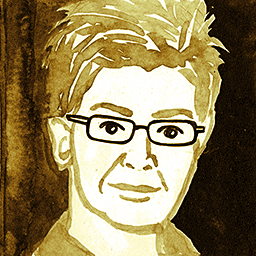
Speaking With, Writing For
Creating Understandable Election Information
By Whitney Quesenbery
Unless designers foster a dialog with users, our best projects may fail.
Election offices across the United States are responsible for managing voter education programs: programs explaining how, when, and where to vote. In addition, election offices provide sample ballots for every election. In some states, detailed voter guides (with candidate statements and explanations of ballot measures) are printed and mailed to every registered voter. A lot of time, effort, and budget goes into creating this material.
As part of our mission to co-create delightful government interactions, the Center for Civic Design explores what makes voter guides useful and understandable for new voters, infrequent voters, and people who have never voted. Our recent research resulted in the production of a set of pocket-sized books containing tips for election designers and election advocates (colloquially called our Field Guides to Ensuring Voter Intent)—but we wanted to dig further.
This is how Dana Chisnell and I found ourselves sitting in a library in Berkeley, California, testing a prototype voter guide with people in a program that helps adults learn to read. It was hard work, but the people were determined. One participant told us she had never been able to vote on her own: “For many years… I didn’t know how to do it, so I let my husband do my ballot.”
While I spoke with her, Dana worked with a 60-something year old man—let’s call him Bill. One of the first pages in our prototype was the California Voter Bill of Rights. Bill worked through it slowly, carefully. When he finished the first paragraph, Bill looked up with a sad-happy-questioning face and asked “This says I can vote again?” It was the first time he’d heard he could have his voting rights restored since leaving prison.

This was a dramatic moment for everyone. It reminded Dana and me of the importance of sitting with people like Bill, especially in light of the embarrassingly low participation in elections. Civic designers are failing if we are not speaking to people (especially through official channels) in a way that they can comprehend and act upon. This isn’t only about elections; elections are the tip of the iceberg. When people don’t know how government works they miss all sorts of opportunities to shape their community.
“It’s important to know your rights”
Although we’d spoken with almost 100 voters, dozens of election officials, and government advocates, it wasn’t until we started sifting through the data that we realized how much Bill’s epiphany (and the Voter Bill of Rights) stood out.
Dana and I knew there was an official California Voter Bill of Rights, but we weren’t convinced that it was an important element in a voter guide. In our first round of research we included the Bill of Rights just to get reactions—as an example of “official information.” We were incredibly surprised when person after person told us they liked it.
“It’s important to know your rights.”
“I would read this.”
“A lot of people could use information like this.”
With all that evidence, we decided to put it in our actual prototype—at the back, of course. We were again surprised when people insisted that it be moved to the front!
“Move this to the front—really. It’s lost here. These are things you need to know early on.”
“Yes. Let us know our rights. People are ashamed to ask.”
“Put this right inside the front cover. Definitely good info. Let all voters know.”
So we did. This made the Voter Bill of Rights one of the first pages Bill found when he opened his guide.
Like many others, Bill didn’t take his rights for granted; he wanted to know exactly what they were. It turns out that when citizens don’t feel included in civic life they need to see their rights and responsibilities spelled out. As designers, we frequently make choices about who we consider part of our audience. Too often, people like Bill don’t make the cut.
It turns out that when citizens don’t feel included in civic life they need to see their rights and responsibilities spelled out.
Making a better Voter Bill of Rights
We didn’t stop there, though. We noticed that Bill had difficulty reading the Bill of Rights because it was full of words he didn’t know. In fact, almost half of adults in the U.S. can’t easily read anything but the most basic information; text with words like “provisional ballot,” “intimidation,” “fraudulently,” and “execution of their duties” is more suited to intermediate or proficient readers.
To be fair, the Bill of Rights isn’t the worst legal writing out there, but try reading the first paragraph to get a sense of how difficult this is for someone who doesn’t read well or isn’t familiar with the terminology:
You have the right to cast a ballot if you are a valid registered voter. A valid registered voter means a United States citizen who is a resident in this state, who is at least 18 years of age and not in prison or on parole for conviction of a felony, and who is registered to vote at his or her current residence address.
Our next step was to think about how to make the Bill of Rights easier to read without changing its meaning. We turned to a few experts in plain language as well as experts in writing for people with low reading literacy and asked them to suggest a rewrite. Then we combined the best edits from all four versions into our final recommendations.
After a few revisions, the paragraph above became:
You have a right to cast a ballot if you are a registered voter. You can register to vote if you are:
- a U.S. citizen,
- at least 18 years old,
- not in prison or on parole,
- registered to vote where you currently live.
We think this is a lot easier to read, even before we’ve had a chance to test it.

Sometimes our plain-language text actually consists of more words; sometimes we’ve been able to shorten the text. A few of the rights were clear enough that they didn’t need editing. Both versions fit on one page. …
A few more examples:
Before: You have the right to cast a secret ballot free from intimidation.
After: [You have a right to…] cast a secret ballot without anyone bothering you or telling you how to vote.
Before: You have the right to election materials in another language, if there are sufficient residents in your precinct to warrant production.
After: [You have a right to…] get election materials in a language other than English if enough people in your voting precinct need a ballot in that language.
Even simple words can be confusing
The Voter Bill of Rights isn’t the only example of information that people find confusing; even things that sound simple can be misleading. Consider the ways in which municipalities might explain a person’s options for voting: in most states, voters can go to a polling place on Election Day, vote by mail (or “absentee” vote, as it’s still called in many places), or come to a county office to vote before Election Day. In addition, there are special provisions for military and overseas voters.
Elections in the U.S. are run by states, counties, cities, and towns, so there’s a lot of variation. Nevertheless, the three ways to “vote before election day” are typically called “early voting,” “vote by mail,” and “vote at the polls”—seems clear, right?
They are nice simple words, but they’re not so simple for people who have never voted. We heard:
“I got this booklet in the mail, so I must be a vote-by-mail voter…?”
“You have to mail your ballot early, so that’s… early voting?”
“You can also drop off your ballot on Election Day, so is that voting at the polls?”
| Voting option | Before Election Day | On Election Day |
| Vote by mail | Yes, from home | Yes, drop off your ballot |
| Early voting | Yes, in person | No |
| Vote at the polls | No | Yes, in person |
In the end, a very small change in the text helped everyone understand that these are three options, not a sequence of actions. The “3 ways to vote” were listed as:
- Vote by mail
- Vote early in person
- Vote at the polls in person
Clarity first
So what can we learn from this work? Many things became clear to me after our research:
First, language is part of the interface. It’s not enough to have short sentences and easy words (though that’s often a good start); we have to explain concepts clearly and use terminology that people understand. This isn’t “dumbing down” information; it’s good communication.
Second, listening is just as important as speaking. This means “working with” the people who will use what we create, not just making things for them. Dana and I would have missed many things had we not taken the time to explore both existing voter guides as well as our prototypes with voters and non-voters. Without getting out of the office (and into community settings such as libraries, LGBT centers, gyms, senior centers, and shopping malls) we would never have met someone like Bill.
Third, iteration is key. Whereas complex civic information can be hard to grasp, words are often easy to change. The earlier we tested our concepts, the better our end result. To quote from the Best Practices Manual for Official Voter Information Guides in California, “the importance of plain language to bridge the civic literacy gap cannot be overstated.”
It would be great to think that we could recommend a few edits and everyone would adopt them. Unfortunately, civic design can run up against legal realities. In our case, the California Voter Bill of Rights is part of the California Election Code. This means changing the official language requires negotiating a political process—a bigger challenge than just editing some text.
We were lucky in this project. Too often, research is separated from action. Our work, however, is part of a larger project called the Future of California Elections (FOCE). FOCE “brings together election officials, civil rights organizations and election reform advocates to examine and address the unique challenges facing the State of California’s election system.” All of the FOCE members are committed to change, and open to new ideas. We were also lucky to partner with the League of Women Voters of California Election Fund, who are carrying the research forward as part of their advocacy work.
But most importantly, we took the time to sit with people like Bill, to speak with them, and learn from them. Our work was better for it.
Like this kinda stuff?
Consider donating to help us to continue doing this work! We also encourage reader comments via letters to the editor.
 Whitney Quesenbery is the co-director of the
Whitney Quesenbery is the co-director of the